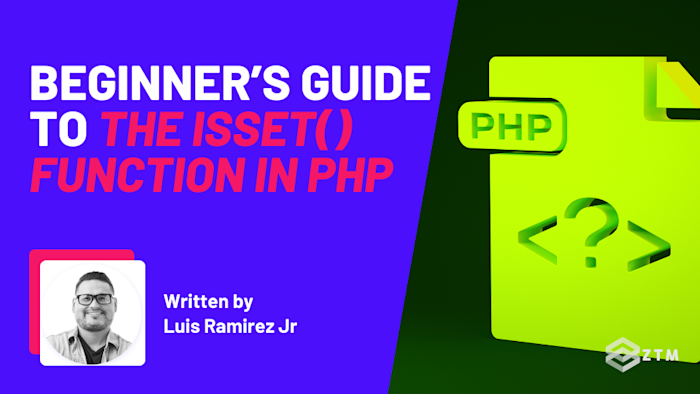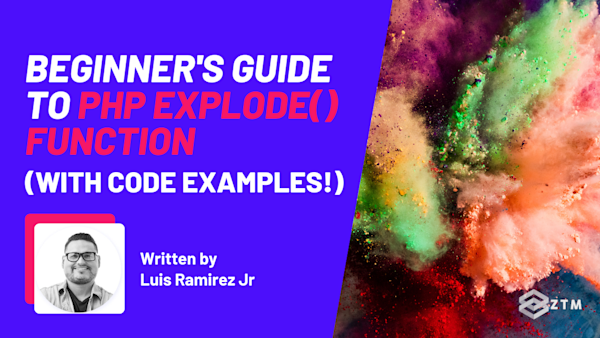Have you ever had your PHP code throw an error about something not being there — even though you were almost sure it was? Maybe it was a form field, a session value, or just a simple variable that didn’t exist when you needed it.
It’s frustrating, especially when PHP doesn’t give you much to work with.
The good news is that there’s a built-in function that can help you catch those issues before they happen. You just need to know what it is and how to use it.
So in this quick guide, we’ll take a closer look at what isset() does, why it matters, and how to use it to make your code more predictable and less error-prone.
Sidenote: If you want to dive even deeper into PHP and it’s more advanced features, or just want to learn PHP from scratch, then check out my complete PHP Development course.
I guarantee that this is the most comprehensive and up-to-date PHP Bootcamp course that you’ll find.
Better still, It’ll take you from absolute beginner to mastering PHP web development, getting hired, and advancing your career!
With that out of the way, let’s get into this 5-minute tutorial.
What is the isset() function in PHP?
At its core, isset() is a simple way for your code to ask: “Does this variable exist, and is it not null?”
That’s it. That’s the whole job.
You pass in a variable, (or even several), and PHP will return true if all of them are defined and not set to null. Otherwise, it returns false.
Why does this matter?
Because PHP doesn’t always warn you when you’re about to use a variable that hasn’t been defined. And when it does, it’s usually in the form of a frustrating notice like:
Notice: Undefined index: emailThis happens all the time with things like form fields, query strings, or session values that might or might not be there depending on how the user interacts with your site.
That’s where isset() comes in. It lets you safely ask, “Is this actually here before I use it?” and avoid those warnings.
For example
Let’s say a form submits an email field:
if (isset($_POST['email'])) {
// Now it's safe to use $_POST['email']
echo $_POST['email'];
}This tells PHP: “Only try to use this if it’s actually there”. Without that check, PHP might throw a warning and interrupt your script.
TL;DR
The best way to think of isset() as a quick safety check to protect your code from breaking when data is missing, especially when it comes from outside sources.
It’s not about what the variable contains. It’s about whether it’s safe to use at all.
Simple!
So now that you understand what isset() does, the next step is knowing where and when to use it.
How to use isset() in PHP
In real-world PHP code, you’ll mostly use isset() inside if statements. Especially when working with form input, query strings, sessions, cookies, or data that might not always be there.
Let’s walk through the most common situations where isset() comes in handy, and how to use it correctly in each one.
Checking a single variable
This is your first line of defense when handling unpredictable input or loosely structured code.
For example
Sometimes you’re not sure whether a variable has been set yet. Or maybe it depends on user input, an optional setting, or a conditional assignment earlier in your code.
Trying to access it without checking could lead to warnings or broken logic.
if (isset($variable)) {
// safe to use $variable here
}This tells PHP to only run this block if $variable exists and hasn’t been set to null. If the variable doesn’t exist or has been assigned null, isset() returns false, then your code stays safe.
Checking multiple variables
In real-world code, you’re rarely just checking one thing. You’re usually validating a group of values, such as several form fields or configuration flags that your code depends on.
Instead of writing multiple isset() checks, you can combine them into one call:
if (isset($a, $b, $c)) {
// only runs if all three are set and not null
}If even one of them is missing or null, the entire condition returns false.
This is especially useful when validating form input.
For example
if (isset($_POST['name'], $_POST['email'])) {
// both fields exist and are not null
}It keeps your validation logic clean and reduces the chances of missing something that causes a warning later.
Checking array values
If you’re working with data from outside your code, like user input or browser cookies, there’s no guarantee the value will be there when you try to use it.
That’s especially true when working with PHP’s superglobals: $_POST, $_GET, $_SESSION, and $_COOKIE. These arrays change based on how someone interacts with your site, so if you try to access a missing key, PHP will throw a warning.
The good news is that this is where isset() shines.
For example
if (isset($_GET['page'])) {
$page = $_GET['page'];
}This tells PHP to only grab the page parameter if it was actually submitted in the query string.
It works the same way for associative arrays you define yourself:
$user = [
'name' => 'Chaima',
'email' => 'chaima@example.com'
];
if (isset($user['email'])) {
echo $user['email'];
}Without this check, accessing a missing key like $user['email'] could throw a warning, even if you’re just checking it in a condition.
Working with nested arrays
Things get trickier when your data structure goes a level deeper.
For example
Say you’re working with nested form input like $_POST['user']['email']. If the parent key (user) isn’t there, PHP will throw a warning the moment you try to dig into it.
isset() lets you guard against that in one go.
if (isset($_POST['user']['email'])) {
echo $_POST['user']['email'];
}It checks the structure from left to right. So if $_POST['user'] doesn’t exist, it stops right there. No error, no warning, just a safe check.
This is a great habit for whenever you're dealing with nested user-submitted data.
Checking object properties
Just like arrays, object properties might not always exist, or they might be explicitly set to null. This means that trying to access them without a check can lead to fragile code.
For example
class Post {
public $title;
public $body = null;
}
$post = new Post();
$post->title = 'Hello world';
if (isset($post->title)) {
echo $post->title; // Hello world
}
if (isset($post->body)) {
echo $post->body; // won't echo because it's null
}This works exactly like the array version. If the property exists and is not null, isset() returns true. Otherwise, it returns false with no warnings, and no crashes.
Common mistakes when using isset() and how to avoid them
Even though isset() is simple, it’s easy to misread what it’s actually doing, especially when you're using it to check things like form inputs, session data, or optional parameters.
So here are the most common mistakes developers run into, along with how to avoid them.
Mistake #1. Assuming isset() checks if a value is empty or false
This is one of the most common misunderstandings when using this feature.
Like I said earlier, isset() only checks whether a variable exists and is not null. That’s it. It doesn’t care if the value is false, 0, an empty string, or even an empty array.
So if you’re expecting it to catch “empty” values, it won’t behave the way you think.
For example
$value = '';
var_dump(isset($value)); // true$value = 0;
var_dump(isset($value)); // trueAs you can see, even though those values might seem “empty”, isset() returns true because the variable is set and not null.
Why does it work this way?
Because isset() was designed to be a lightweight, low-overhead presence check and not a truthiness check.
All it does is answer:
- Has this variable (or key) been defined?
- Is it not explicitly
null?
This simplicity makes it safe to use without triggering notices or errors - even in deeply nested structures, while also keeping it fast.
Not only that, but PHP already provides a separate function, empty(), for when you want to check truthiness or whether a value “feels” empty ('', 0, false, null, etc.).
So, by separating these concerns, PHP gives you two distinct tools:
isset()for: “Can I safely use this variable?”empty()for: “Does this variable have a meaningful value?”
If isset() tried to do both, it would lose its value as a safe, low-cost guard against undefined or null values, especially when falsy values like 0 or false are perfectly valid in your logic.
Make sense?
What to do instead
If you want to check whether a value is truly empty (including '', 0, false, [], or null), use the empty() function.
Just remember: empty() is stricter, and it behaves differently. So always be clear on what you're checking for existence, or emptiness.
But use isset() when you only want to know: “Is this set and not null?”
Mistake #2. Using isset() when array_key_exists() would be more accurate
Now that you know isset() returns false for variables or keys set to null, there’s one situation where that behavior can backfire: when you're checking whether an array key exists at all, even if the value is null.
For example
$data = ['username' => null];
var_dump(isset($data['username'])); // false
var_dump(array_key_exists('username', $data)); // trueAs you can see, even though the key username exists in the array, isset() reports it as not set, because the value is null.
That can lead to logic bugs where you mistakenly assume the key was never there.
What to do instead
- Use
array_key_exists()when your goal is to check for the presence of a key, regardless of its value - Use
isset()only when you care that a key is both present and not null.
Mistake #3. Trying to check a nested value without checking the parent first
One of the most common places developers run into issues is with nested data, especially when working with form submissions, session values, or API responses.
For example
Let’s say you’re expecting a form field like this:
$_POST['user']['email']Do you see the problem? It looks fine up until $_POST['user'] isn’t there. (Maybe the user didn’t fill that part out, or the HTML was tampered with).
And so the moment you try to access ['email'], PHP throws a warning.
// Risky: throws warning if 'user' key isn’t set
$email = $_POST['user']['email'];A common attempt to solve this is to assign the parent first and check the child, like so:
$user = $_POST['user'];
if (isset($user['email'])) {
echo $user['email'];
}But that doesn’t work either because the warning already happened on the assignment line.
What to do instead
Use isset() on the full path before assigning or accessing deeper values. This way it prevents runtime warnings and keeps your logic clean.
For example
if (isset($_POST['user']['email'])) {
echo $_POST['user']['email'];
}isset() checks from left to right and stops at the first undefined piece, so this approach prevents any notice or error from being triggered.
This is one of the safest ways to deal with structured input in PHP, and is a great habit worth forming any time you're working with nested arrays.
Mistake #4. Using isset() instead of proper validation
Once you start using isset(), it’s easy to over-rely on it, especially when handling form submissions or user input.
if (isset($_POST['email'])) {
// assume it's valid and go
}But here’s the problem.
Just because a value exists doesn’t mean it’s safe or valid. It might be an empty string, a poorly formatted email, or even something the user intentionally manipulated.
isset() only tells you that the variable is present and not null. That’s all.
What to do instead
Think of isset() as your first gate. It protects your code from warnings and lets you check whether something is there.
But once it passes that check, you still need to:
- Sanitize the input
- Validate the format
- Apply business rules (e.g., check if it’s unique, in range, allowed, etc.)
For example
if (isset($_POST['email']) && filter_var($_POST['email'], FILTER_VALIDATE_EMAIL)) {
// Now it’s both present and valid
}The key thing to remember is that isset() helps your code run without errors, but validation helps it run correctly.
Mistake #5. Setting a default fallback value
You’ve probably noticed that checking if a variable exists with isset() is a bit verbose — especially when you just want to use a fallback value if something isn’t set.
For example
Take this classic pattern:
if (isset($_POST['name'])) {
$name = $_POST['name'];
} else {
$name = 'Guest';
}This works, and it’s safe. But PHP gives you a shortcut that makes this kind of check a lot cleaner and easier to read. The ?? operator, introduced in PHP 7, lets you do this:
$name = $_POST['name'] ?? 'Guest';That one line replaces the entire if-else block. It checks whether $_POST['name'] is set and not null and if it is, it uses the value. If not, it falls back to 'Guest'. Just a quick, elegant fallback.
Give isset() a try in your own code!
So as you can see, although isset() is fairly basic, it can easily help you to avoid unexpected errors when working with data you don’t fully control. Whether that’s a form field, session variable, or query parameter, it gives you a quick way to check if something is actually there before you use it.
The best way to understand this through is to try it out in your own projects. So go ahead and add a few isset() checks around form inputs or session data and see how it changes your own error handling.
P.S.
If you want to learn more about these loops and every other important aspect of PHP, check out my complete course on modern PHP.
I guarantee that this is the most comprehensive and up-to-date PHP Bootcamp course available today. It will help you to go from absolute beginner to mastering PHP web development, getting hired, and advancing your career.
And as an added bonus?
When you take this course and join the Zero To Mastery Academy, you’ll also have access to every Web Development course that we have (as well as every other course), so you can follow a complete path to becoming a working professional Web Developer.
Not only that, but you also get access to our private Discord server!
You can ask questions to me directly (or any teacher) as well as fellow students and working professionals.
So what are you waiting for? Join now, and I’ll see you in Discord!
Want more PHP guides?
Check out these other PHP tutorials:










